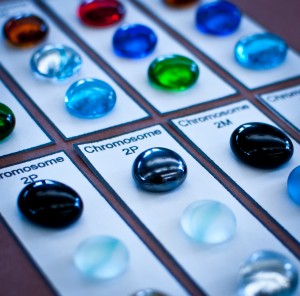In several classes having to do with genetics, I use paper chromosomes with glass stones to represent genes on those chromosomes. Different colored stones at the same position represent different alleles of that gene.
As with the other simulations on this site, having a physical representation to manipulate aids students in their understanding of complex processes. For example, when performing meiosis, students experience how gametes are formed and can see how crossover and independent assortment lead to an immense variety of gametes. This then directly translates to their ability to solve genetics problems involving Punnett Squares, in which the genotypes of potential offspring are determined. Often, I find students can do simple Punnett Squares but then have no idea how to even begin a more complex one. Since gametes from each parent are the row and column headings of the Punnett Square, it indicates that they simply do not understand the production of gametes through meiosis. By actually generating the gametes through manipulating the alignment of chromosomes and swapping genetic material between non-sister chromatids, students are better able to set up and solve novel Punnett Squares. Once they can do that, they are able to understand the variation in phenotypes seen in populations and how the average phenotype might change over time (see evolution of skin color).

Comments are closed, but trackbacks and pingbacks are open.